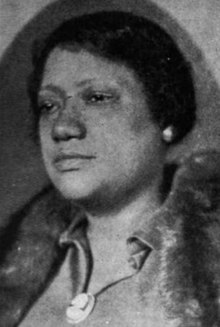Addie Whiteman Dickerson (1878–1940) was a businessperson, politician, clubwoman, suffragist, and peace activist.
Biography
editDickerson née Whiteman was born in 1878[1] in Wilmington, North Carolina. She attended the Gregory Normal School and Scotia Seminary.[2]
In 1908 she married G. Edward Dickerson[2] with whom she had one child.[3] The couple settled in Philadelphia, where Dickerson had a career as a real estate broker and served as the first female African American notary public in Pennsylvania.[2]
Dickerson was active as a clubwoman and suffragist.[4] She was a founding member of the Philadelphia chapter of the Federated Women's Club. She was also a member of the National Association of Colored Women, and the National Council of Negro Women.[2]
After American women won the right to vote, Dickerson ran for a seat on the Pennsylvania House of Representatives in 1930 as a Republican. She did not win. For a time she served as chairman of the Philadelphia Republican Council of Colored Women. Dickerson was also an advocate on behalf of the international peace movement. She was a founding member of the International Council of Women of the Darker Races (ICWDR). She became president of the organization in 1928.[2]
Dickerson died on May 31, 1940.[1]
Legacy
editBoth Addie and G. Edward Dickerson died in 1940. They left their combined estate of about $100,000 worth of Philadelphia real estate to establish the G. Edward and Addie W. Dickerson Foundation. In 2018 a mural honoring the Dickersons was painted at the Art Sanctuary Philadelphia by the muralist Ernel Martinez[3] as part of the Philadelphia Mural Arts Program.[5] The Art Sanctuary Philadelphia is located in a building originally owned by the Dickersons.[6]
References
edit- ^ a b Fry, Jennifer Reed (2013). "Dickerson, Addie Whiteman". African American Studies Center. doi:10.1093/acref/9780195301731.013.35583. ISBN 978-0-19-530173-1. Retrieved 13 February 2022.
{{cite book}}:|website=ignored (help) - ^ a b c d e "Biographical Sketch of Addie Whiteman Dickerson". Alexander Street. Archived from the original on 2022-03-14. Retrieved 13 February 2022.
- ^ a b Booker, Bobbi. "Mural honors city's early Black power couple". The Philadelphia Tribune. Archived from the original on 2022-03-14. Retrieved 14 February 2022.
- ^ Who's who in Colored America. Who's Who in Colored America Corporation. 1942. p. 157.
- ^ "Philadelphia Mural Honors Couple That Sought to 'Improve Negro Race,' Detroit Art Week, Rashid Johnson Wins Aspen Award". Culture Type. Archived from the original on 2022-02-14. Retrieved 14 February 2022.
- ^ "Our Venue History". Art Sanctuary. Archived from the original on 2016-09-13. Retrieved 14 February 2022.
